| North Korea 조선민주주의인민공화국 | |||||
|---|---|---|---|---|---|
| |||||

| |||||
| Capital | |||||
| Languages | |||||
| Demonym |
North Korean • Korean | ||||
| Currency | |||||
| Establishment | |||||
|
-Liberated |
August 15, 1945 | ||||
|
-Declaration |
September 9, 1948 | ||||
| GDP (PPP) | |||||
| -Total |
$45 billion (2011) | ||||
| -Per capita |
$2400 (2011) | ||||
| GDP (nominal) | |||||
| -Total |
$3.27 billion (2011) | ||||
| -Per capita |
$1800 (2011) | ||||
| v · d · e | |||||
The Democratic People's Republic of Korea (DPRK; Chosŏn'gŭl: 조선민주주의인민공화국; Chosŏn Minjujuŭi Inmin Konghwaguk), commonly referred to as North Korea, is a country located in East Asia, in the northern half of the Korean Peninsula. It is bordered by the People's Republic of China to the north, a small portion of Russia to the east, and South Korea to the south. It also has coastlines on the Korea Bay, Yellow Sea, and Sea of Japan.
History[]
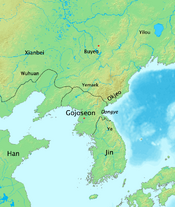
Korea in 108 BC
The Korean Peninsula is believed to have been inhabited from the Lower Paleolithic about 400,000 to 700,000 years ago. Gojoseon, the first Korean kingdom, is claimed in the Samguk Yusa (1281) and other medieval Korean books to have been established in northern Korea in 2333 BC by Dangun. However, such accounts are deemed questionable due to the lack of historical evidence. The state of Jin was later established in the south of the Korean peninsula. Around 100 BC, Jin evolved into the Samhan confederacies, and in 108 BC, Gojoseon was disestablished when its capital, Wanggeom-seong, fell at the hands of the Han Dynasty. The Proto-Three Kingdoms of Korea period began after Gojoseon's defeat, and during this time, a number of small states appeared on the Korean peninsula, including Bukbuyeo, Dongbuyo, Okjeo, and Dongye. The Three Kingdoms of Korea: Goguryeo, Baekje, and Silla, later emerged and conquered these small states. After the decline of the three kingdoms, the North and South States Period began in 698. During this time period, Unified Silla made up the northern portions of the peninsula while Balhae consisted of the southern territories. The states of Hubaekje and Taebong were established as Silla declined in power during the late 9th and 10th centuries. When Wang Geon became leader of Taebong in 918, he ceded the small state to his newly founded Kingdom of Goryeo. With aims of unifying the entire Korean peninsula, the southern portions of Balhae were absorbed into Wang's kingdom, and the territories of Silla and Hubaekje were subsequently annexed as well.

The signing of the Korean Armistice
The Kingdom of Goryeo thrived until it was overthrown by Yi Seong-gye (later Taejo) and his Joseon dynasty. During the existence of this dynasty, Korea encountered many foreign interventions and invasions, most notably by Qing China, France, Azuchi-Momoyama Japan, the United Kingdom of Great Britain and Ireland, and the United States. After Japan forced Korea to open its ports in 1876, the island country challenged the Qing Dynasty in the Sino-Japanese War (1894-1895). As a result of this, the 1895 Treaty of Shimonoseki was concluded between China and Japan, and abolished the traditional relationships between Korea and the former. Joseon was renamed the Korean Empire in 1897, and continued to be ruled by the descendants of Yi Seong-gye. It existed until 1910 when it was effectively annexed by the Empire of Japan per the Japan–Korea Treaty of 1910. The Korean peninsula remained part of Japan until 1945, when the country surrendered to the allies at the end of World War II. Korea was then divided into two occupational zones, with the United States administering the southern half of the peninsula and the Soviet Union controlling the northern half. The modern Democratic People's Republic of Korea (North Korea) was established upon the departure of Soviet troops in 1948. However, tensions between the communist north and the republican south ultimately led to the Korean War, fought from 1950 until the signing of the Korean Armistice Agreement in 1953. Since then, relations between North Korea and South Korea, Canada, the European Union, the United States, and Japan have been tense. In 2000, North and South Korea promised to seek peaceful reunification, but during March 2013, North Korea confirmed it ended the 1953 Armistice and declared that the DPRK "is not restrained by the North-South declaration on non-aggression". The country is currently a Juche single-party socialist republic led by Supreme Leader Kim Jong-un.
Economy[]
- Main article: Economy of North Korea
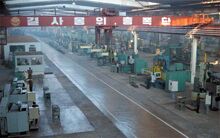
The Democratic People's Republic of Korea has an industrialized, nearly-autarkic, highly centralized command economy. Along with Cuba, the nation is one of two states with an almost entirely government-planned, state-owned economy. North Korea's Central Planning Committee is responsible for the preparation, supervision, and implementation of economic plans, while a regional General Bureau of Provincial Industry manages local manufacturing facilities, production, resource allocation, and sales.
International trade between North Korea and other countries is largely restricted due to the nation's isolationist policy. In 1984, North Korea passed a law that would allow for foreign investment through joint ventures, but was unsuccessful at attracting any significant investments. It established the Rason Special Economic Zone near Rason in 1991 to attract investments from China and Russia, with more success.
Until 1998, the United Nations published GDP per capita rates for North Korea, which at the time had a GDP figure of $4058. During 2004, the average monthly salary was about $47. The average official salary in 2011 was about $2 per month while the actual monthly income is probably around $15 because many North Koreans make money from illegal small businesses, including trade, subsistence farming, and handicrafts. The nation's illegal economy is dominated by women because men have to attend official work although many North Korean factories are currently not functioning. It is estimated that in the early 2000s, the average family in North Korea drew approximately 80% of its income from illegal small businesses in the country.
In spite of significant economic problems, quality of life in North Korea was improving and wages were increasing slowly in 2007. A number of small-scale private markets are found across the country and provide the people with imported food and commodities in exchange for money. The government carried out a currency redenomination for the won in 2009 with the intent of restraining the free market activity in the country, but the attempt failed and caused inflation rates to greatly increase, and eventually led to the lifting of the ban on free market trade.
Certain necessities, including food rations, housing, healthcare, and education are offered by the country for free, and the payment of taxes has been abolished since April 1, 1974. With aims of increasing productivity from agriculture and industry, the North Korean government has introduced a number of management systems since the 1960s, including the Taean work system. During the early 21st century, following a recovery in 1999, North Korea's GDP growth was slow and steady until 2005. Between 2006 and 2011, each year excluding 2008 and 2011 had negative growth. The following estimates of North Korea's GDP growth were published by the Bank of Korea, South Korea's central bank, in 2012:
| 2000 | 2001 | 2002 | 2003 | 2004 | 2005 | 2006 | 2007 | 2008 | 2009 | 2010 | 2011 |
| 0.3% | 3.8% | 1.2% | 1.8% | 2.1% | 3.8% | -1.0% | -1.2% | 3.1% | -0.9% | -0.5% | 0.8% |
According to 2002 estimates, the dominant sector of the North Korean economy is industry (43.1%), followed by services (33.6%), and then by agriculture (23.3%). In 2004, an estimated 37% of the North Korean workforce is employed by agriculture while the remaining 63% includes those employed in industry and service. Major industries in the Democratic People's Republic of Korea include chemicals, electric power, food processing, machine building, metallurgy, military products, mining, textiles, and tourism. Production of iron ore and coal in North Korea are among the few sectors where the country performs better than its southern neighbor.
Rice yields are approximately 2.8 tons per hectare, about half that in a majority of countries, with soil degradation, lack of fertilizers, and limited mechanization blamed. The Food and Agriculture Organization (FAO) ranked North Korea in 2005, and was estimated as 10th in the production of fresh fruit and 19th in the production of apples. The country has a number of natural resources and is the world's 18th largest producer of iron and zinc. It is also the 15th largest producer of fluorite and the 12th largest producer of copper and salt in Asia. Other abundant natural resources include fluorspar, gold, graphite, hydropower, lead, magnesite, pyrite, and tungsten.
Famine[]

|
This page uses Creative Commons Licensed content from Wikipedia (view authors). |
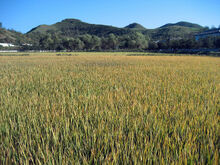
A rice field near Wonsan
North Korea faced several economic disruptions during the 1990s, including a series of natural disasters, economic mismanagement, and significant resource shortages after the fall of the Eastern Bloc. Such disruptions resulted in a shortfall of staple grain output. The North Korean famine, known as the Arduous March, resulted in the deaths of between 300,000 and 800,000 citizens in North Korea each year over a three year period beginning in 1994. A majority of the deaths are believed to have been caused by famine-related illnesses including diarrhea, pneumonia, and tuberculosis rather than starvation.
In 2006, the North Korean government, the World Food Programme, and the United Nations Children's Fund (UNICEF) conducted a national nutrition survey. This survey revealed that at the time, 7% of children in the country were severely malnourished, 37% were chronically malnourished, 23.4% were underweight, and one in four mothers was malnourished and anemic because of the lingering effects of the famine. The inflation caused by some of the 2002 economic reforms, including the Songun or "Military-first" policy, was cited for creating the increased price of basic foods.
The history of Japanese assistance to North Korea has been marked with challenges; from a large pro-Pyongyang community of Koreans in Japan to public outrage over the 1998 North Korean missile launch and revelations regarding the abduction of Japanese citizens. In June 1995, an agreement was reached that the two countries would act jointly. South Korea would provide 150,000 tons of grain in unmarked bags, and Japan would provide 150,000 tons gratis and another 150,000 tons on concessional terms. In October 1995 and January 1996, North Korea again approached Japan for assistance. On these two occasions, both of which came at crucial moments in the evolution of the famine, opposition from both South Korea and domestic political sources quashed the deals.
Beginning in 1997, the U.S. began shipping food aid to North Korea through the United Nations World Food Programme (WFP) to combat the famine. Shipments peaked in 1999 at nearly 700,000 tons making the U.S. the largest foreign aid donor to the country at the time. Under the Bush Administration, aid was drastically reduced year after year from 350,000 tons in 2001 to 40,000 in 2004. The Bush Administration took criticism for using "food as a weapon" during talks over the North's nuclear weapons program, but insisted the U.S. Agency for International Development (USAID) criteria were the same for all countries and the situation in North Korea had "improved significantly since its collapse in the mid-1990s." Agricultural production had increased from about 2.7 million tons in 1997 to 4.2 million tons in 2004.
In 2013, there were reports of famine returning to parts of North Korea and driving some to cannibalism, with the claims that one man dug up his grandchild's corpse to eat and another boiled his child and ate the flesh. Another man was allegedly executed after murdering his two children for food. However, the World Food Program reported malnutrition and food shortages, but not famine.
International trade[]
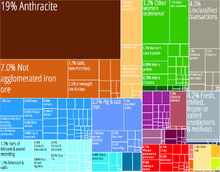
A graphic depiction of North Korean exports
North Korea's biggest trade partners are China and South Korea, with trade with China increasing to US$1.6 billion in 2005, and trade with South Korea increasing to over $1 billion during the same year. China is North Korea's closest economic partner, and it accounts approximately 70% of foreign trade with the nation.
In 2000, the North Korean Ministry of Foreign Trade established the Center for the Study of the Capitalist System in the country. Since 2002, an increased number of foreign-invested joint ventures have been set up in North Korea. The Swiss government established the Pyongyang Business School to help teach students business management.
Beginning in 2000, Taiwan (the Republic of China) has exported nuclear waste to North Korea for disposal.
Investors from Europe have coordinated with North Korea in the development of freelance computer programming employment opportunities. One such venture, Nosotek, was founded in 2008.
In January 2013, North Korea purchased nearly 16,000 video cameras from China in order to conduct Mass surveillance on its citizens.
Private commerce[]
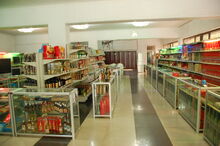
A department store in Pyongyang
North Korea began experimenting private capitalism in its Rason Special Economic Zone in 1991, and subsequently established the Kaesong Industrial Region in 2002. A small number of other locations have been designated as Special Administrative Regions.
Certain capitalistic elements have been gradually spreading from Rason, including a number of advertising billboards displayed on certain highways. Recent visitors to North Korea have claimed that the number of farmers' markets has increased in Kaesong and Pyongyang, as well as on the China-North Korea border, thus bypassing the national food rationing system. In addition to food aid, China reportedly provides approximately 80 to 90 percent of North Korea's oil imports at relatively low prices.
Tourism[]

The Yanggakdo Hotel
Tourism in North Korea is organized by the Korea International Travel Company. All tourists/visitors to the country are typically accompanied by at least one guide who usually speaks that person's native language. While tourism in North Korea has increased recently, tourists from Western countries remain minimal.
A majority of North Korean visitors are natives of neighboring China, Russia, and Japan. It is nearly impossible for a citizen of South Korea to get a visa to North Korea; however, they can get entry permits to special tourist areas for South Koreans. Citizens of the United States were also subject to restrictions, and were only allowed to visit the country during the yearly Arirang Festival until such a restriction was lifted in January 2010. Since 1953, it is estimated that fewer than 2500 U.S. citizens have ever visited the country.
The South Korean conglomerate Hyundai established and currently operates a special tourist area in Mount Kumgang. South Koreans and Americans are permitted to travel in this area, but only in organized groups from South Korea. A special administrative division, the Mount Kumgang Tourist Region, exists for this purpose. Trips to this region were suspended after Park Wang-ja, a 53-year-old South Korean tourist, was shot twice and killed by border guards when she wandered into a North Korean military zone in 2008. When tours had not recommenced by May 2010, the North Korean Government announced it would seize South Korean real estate assets located in the special region.
There are a handful of hotels currently in operation in North Korea, the most notable and largest currently operating of which being the Yanggakdo International Hotel on Yanggakdo Island near Pyongyang.
Numismatics[]
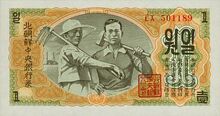
A North Korean note from 1947
The first coins reportedly used on the Korean peninsula were knife coins of the state of Yan, which are believed to have circulated in Korea around 3000 BC. Grain coins were then used on the peninsula for several centuries. The Kingdom of Goryeo was the first entity on Korea to introduce its own coins. Such coins are very similar in appearance to Chinese coins of the period. Around 1097, during the reign of Sukjong, the coins began specifying they hold Korean origin, and the first iron coins became minted and used. Goryeo continued to issue coins until it was overthrown by Joseon in 1392. King Taejong was the first to attempt to improve the monetary system in his kingdom, but was not immediately successful. One of his attempts was to issue a Korean version of the Chinese paper money, and such currency was eventually used in place of coinage.
The coins minted during the 17th century were successful, and as a result, a total of 24 mints were established on the Korean peninsula. The mun was made the main currency of Korea in 1633, and copper and bronze coins of this currency unit circulated until 1892, when it was replaced by the yang. The yang continued to be issued into the early years of the Korean Empire. The won was introduced in 1902, replacing the yang at a rate of 1 won = 5 yang. In 1910, the yen was introduced on the peninsula following the annexation of Korea by the Empire of Japan. Upon its separation from South Korea in 1947, North Korea introduced its own won, which is the currently circulating medium in the country. Some department stores in Pyongyang, however, do not accept the won, and only take Japanese yen and United States dollars. As of November 1, 2012, most stores in the country accept Chinese Renminbi, euros, and U.S. dollars in addition to North Korean won.
| Code | Currency Name | Dates | Conversion | Divisions | |||
|---|---|---|---|---|---|---|---|
| Korean mun |
|
||||||
| Korean yang |
|
100 Bun = 10 Jeon = 1 Yang | |||||
| Korean won |
|
1 Won = 5 Yang | 100 Chon = 1 Won | ||||
| Korean yen |
|
100 Sen = 1 Yen | |||||
| North Korean old won |
|
100 Chon = 1 Won | |||||
| North Korean new won |
|
100 old won = 1 new won | 100 Chon = 1 Won | ||||
| KPW | North Korean third won |
|
100 second won = 1 third won | 100 Chon = 1 Won |
See also[]
- Central Bank of the Democratic People's Republic of Korea
References[]
| Currency Wiki has 8 images related to North Korea. |
| North Korea topics | ||
|---|---|---|
| History | pre-918 • Goryeo (918-1392) • Joseon (1392-1897) • Korean Empire (1897-1910) • Japanese Korea (1910-1945) • Provisional People's Republic (1946-1948) • North Korea (1948-present) | 
|
| Currencies | Coins of Goryeo • Mun (1633-1892) • Yang (1892-1902) • Won (1902-1910) • Yen (1910-1945) • Won (1947-present) | |
| Economy | Central Bank of the Democratic People's Republic of Korea • Economic history of North Korea • Economy of North Korea | |
| Asia | |
|---|---|
| Countries | Afghanistan • Armenia* • Bahrain • Bangladesh • Bhutan • Brunei • Cambodia • China • Cyprus* • Georgia* • East Timor* (Timor-Leste) • India • Indonesia* • Iran • Iraq • Israel • Japan • Jordan • Kazakhstan • Kuwait • Kyrgyzstan • Laos • Lebanon • Malaysia • Maldives • Mongolia • Myanmar (Burma) • Nepal • North Korea • Oman • Pakistan • Philippines • Qatar • Russia* • Saudi Arabia • Singapore • South Korea • Sri Lanka • Syria • Tajikistan • Thailand • Turkey* • Turkmenistan • United Arab Emirates • Uzbekistan • Vietnam • Yemen |
| Partially-recognized states | Abkhazia • Nagorno-Karabakh • Northern Cyprus • Palestine • South Ossetia • Taiwan |
| Non-sovereign territories | Akrotiri and Dhekelia • British Indian Ocean Territory • Christmas Island • Cocos (Keeling) Islands • Hong Kong • Macau |


